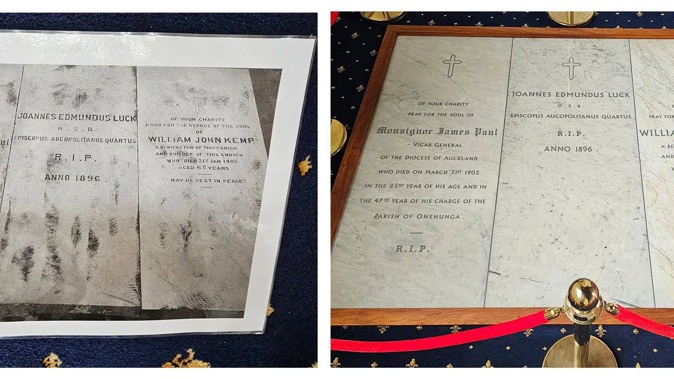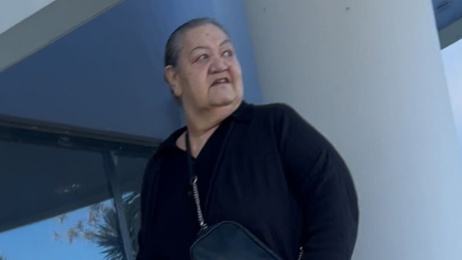
The hidden graves of three church luminaries, including the fourth Catholic Bishop of Auckland, have been found under a city church more than a century after their deaths.
Tradies discovered three side-by-side headstones last year while removing old carpet and carpet tiles at Our Lady of the Assumption in the central Auckland suburb of Onehunga.
No one at the church was available to comment today, but a woman who answered the phone confirmed the graves were found during renovations.
They knew the three men were buried under the church – plaques hang on the church wall in their memory – but not the exact location, she said.
“Since [the discovery], the graves have been restored and blessed by the Catholic Bishop of Auckland, Bishop Steve Lowe on January 28.”
The graves are of the fourth Catholic Bishop of Auckland, John Edmund Luck, who died aged 55 in 1896, Monsignor James Paul, who died in 1905 aged 83 and who was both the original parish priest for Onehunga and the vicar general of the Auckland diocese, and William John Kemp, who built the church and died in 1906 aged 65.
/cloudfront-ap-southeast-2.images.arcpublishing.com/nzme/ZNECSQRELBCZPH6GHQTIFGFHV4.jpg)
John Edmund Luck was the fourth Catholic Bishop of Auckland. He held the role from 1882 until he died in 1896. Photo / Auckland City Libraries
The marble headstones were discovered when two workers began removing carpet tiles - which had previously been under another layer of carpet - so new carpet could be laid directly on the concrete base, Giles Carpets’ owner Kevin Giles said.
The pair were using a diamond grinder when they discovered the headstones, but did not damage them, he said.
“I got a phone call at 7, maybe 8 o’clock at night from my carpet layers telling me they’d found these graves. I said, ‘no, you’re kidding me’.
“I started my business in 1981. I’m 67 years old. And I have never ever struck anything like that.”
This is what the graves, with their headstones above, looked like when they were discovered by men replacing the carpet at Our Lady of Assumption Church in Onehunga last year.
The restored headstones in Our Lady of Assumption Church in Onehunga.
But the pair were insistent, and Giles saw the headstones for himself the next day.
“It’s amazing. How could they have covered that up years ago? That’s what I couldn’t get over.”
Jacobsen’s Headstones stonemason Vaughan Jacobsen was tasked with restoring the grave markers, which are now bordered by timber and visible to parishioners.
“I knew it was going to be a bit of a challenge, but I like a challenge.”
He started by getting the headstones re-polished, before copying the original font on each.
“Then Anna in the office, she matched it as close as she could, and she pretty much got it bang on, and we laid the tape down on the marble.”
They then sandblasted into the marble before making up a metal-colour paint for the lettering, a more durable and economical long-term option than how the headstones were originally made using lead.
“If you’re standing from afar, you’d think it’s lead lettering still. But it’s actually painted on.”
The turn-of-the-20th-century graves were found under Our Lady of the Assumption Church in Onehunga, which was built in the late 1880s on an 1840s Catholic cemetery. Photo / Creative Commons - Winnieswikiworld
The Auckland Diocese was not immediately able to confirm when and why the graves were covered, but Jacobsen said he was told by someone with a long connection to the church that it took place in the 1960s.
“[He said] the head of the church decided to cover those three memorials with carpet, and possibly to add an extra two or three rows of pews in there to get more seating.”
Bronze plaques honouring the men were then added to the wall, the man told Jacobsen.
The carpet was later replaced in the mid-1990s, but not the carpet tiles – allowing the headstones to remain hidden for another three decades.
Mystery surrounding old burial sites is not unknown.
During the mid-1800s 10 nuns were buried in gardens on the Wyndham St side of St Patrick’s Cathedral before five were later moved to Ponsonby.
But extensive subterranean tests during earthworks around the historic Auckland church in 2006 revealed only three graves – leaving the whereabouts of the remaining two nuns a mystery.
Cherie Howie is an Auckland-based reporter who joined the Herald in 2011. She has been a journalist for more than 20 years and specialises in general news and features.
Take your Radio, Podcasts and Music with you

/cloudfront-ap-southeast-2.images.arcpublishing.com/nzme/KJYPRPVTINFO3G4PISNB7HWGFM.JPG)
/cloudfront-ap-southeast-2.images.arcpublishing.com/nzme/RJBGVHQDDZBDDAA3GYRFPD4NDE.JPG)
/cloudfront-ap-southeast-2.images.arcpublishing.com/nzme/XM6JWLJZK5B55NZMKIFBGFDCLE.JPG)








